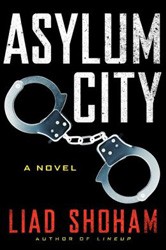Samuel Sattin’s debut novel starts out as Lenard Sikophsky, training for his bar mitzvah and unaware he’s been fed a spoonful of plutonium with each meal for the last six years, is told he has to outrun a speeding train if he hopes to become the superhero his father — consulting an esoteric book passed down from father to son in their family — wants him to be. After that, things get weird.
There’s a pack of antagonists whose hatred for the Sikophskys goes back generations without clear basis. There’s a lion named Steve. There’s a kidnapping of a bride already paid for by the father and intended for rescue by the superhero-in-training. There’s the complicated Scottish/Polish/Jewish heritage that plays out with a bizarre fusion of stereotype and broad humor. There’s the disembodied spirit who offers the occasional journal entry. And there’s another lion named Steve. In short, this is family saga of the most demented (and inventively joyful) kind.
One way of reading the novel, by no means an exhaustive one, is to see it as a metaphor for a suburban Jewish childhood. Lenard finds himself called on by his father to do any number of things that estrange him from the community around him for reasons that it takes an old text to justify. He is born different because of his particular heritage — which is decidedly Jewish in addition to the weirdness of the invented Manatonic tradition of creating superheroes — and he then has the weight of tradition pushing him to make himself even more different. He feels the broad cultural pull to be “like everyone else,” but he also loves and admires his father’s fervor.
Sattin experiments at all times with the novel’s structure and with narrative form. Not all those experiments work, but enough do to make the novel endlessly inventive. Parts are certainly confusing, but that seems much of the point: the story of a family looks and feels different when you move from the perspective of a grandparent shaped by World War II to a grandchild of the twenty first century. This is a novel of bold, laugh-out-loud ideas, but it’s shaped by its subtleties, too. In other words, it’s like an acrylic painting with spots of water color.
Reading League of Somebodies can be difficult because Sattin gives few clues to distinguish between when we’re supposed to laugh (which is almost always) and when we’re supposed to focus on the story’s poignancy. He calls on his readers to step outside the comforts of genre and to follow him as he breaks all sorts of the conventions of fiction. On top of its bizarre humor, it’s a reading experience that is as challenging as it is worthwhile.
Related Content:
- Interviews: Emerging Voices
- Super Boys: The Amazing Adventures of Jerry Siegel and Joe Shuster – The Creators of Superman by Brad Ricca
- The Canvas by Benjamin Stein
- Witz by Joshua Cohen





